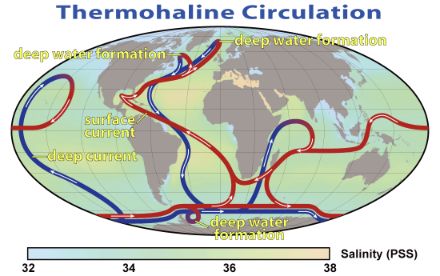Service Navigation
Search
What moves our oceans
Globally, the water masses of the oceans are constantly in motion. Starting in the Atlantic, water flows from the tropics to the high latitudes, where it sinks into the depths and flows southwards again. The deep water flows around the Antarctic and into the Pacific and Indian Oceans, where it is brought back to the surface. This is known as the thermohaline circulation. It is driven by differences in the density of seawater. These differences in density themselves are caused by different water temperatures and varying salt content.

Water from near the equator releases its heat into the cooler atmosphere at higher latitudes and thus cools itself down. In addition, a lot of water evaporates in the subtropics, which causes the salt content to increase as the current travels northwards. In addition, when the water in the Arctic and Antarctic freezes, salt is also deposited in the seawater. In the high latitudes, the water is cold and salty and therefore very heavy - it sinks into the depths. This happens mainly in the waters south and east of Greenland, as well as in the Antarctic.